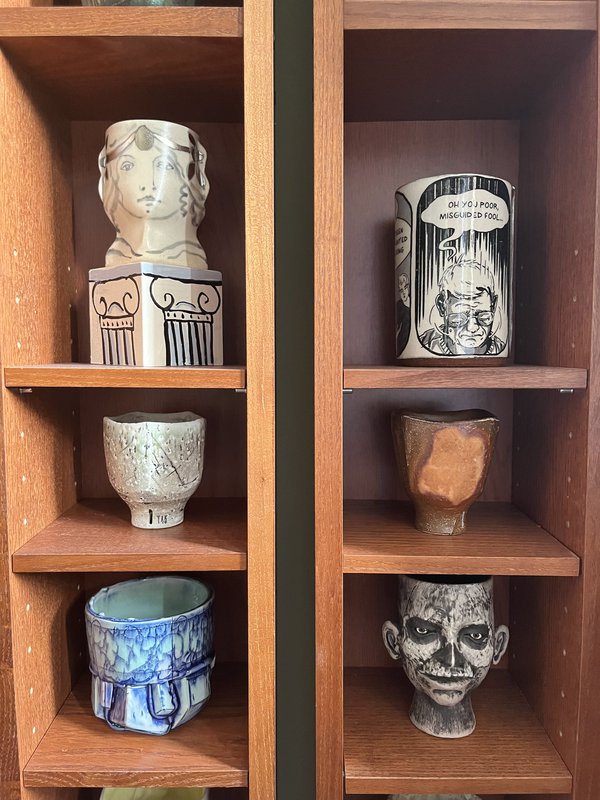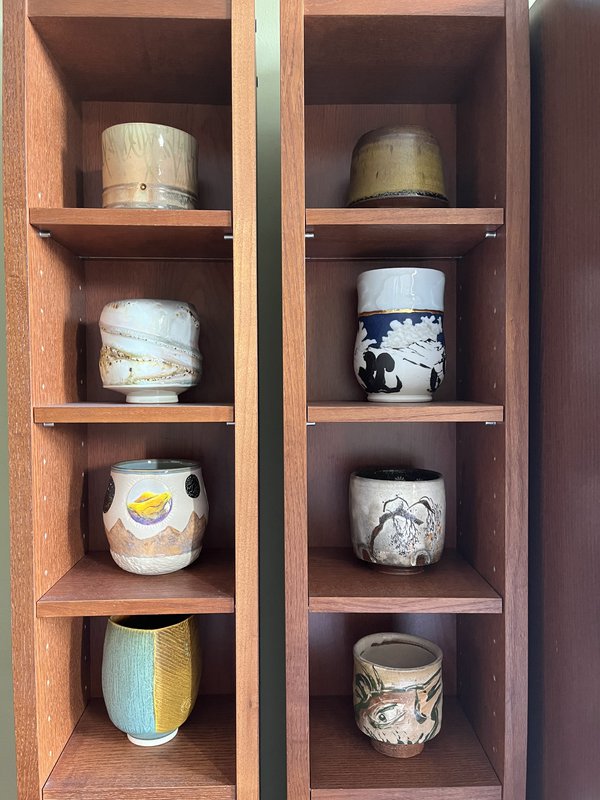I have always hoped the dusty smell of the used bookstore I visited as a university student in upstate New York made its way into my clothing.
I’d spend hours cross-legged on the floor, itching in my wool trousers, digging through the boxes of postcards from the last century and hoping to find the right ones—the ones whose fronts advertised the places I aspired to visit and the ones I longed to return to, whose backs contained the most humorous and most heartbreaking messages.
The most expensive postcards were never more than four dollars, but often that was far too expensive for my late-teenaged budget; nevertheless, I skipped lunches and Tecate beers to afford them.
I keep these postcards in a binder, whose second half contains train ticket stubs and museum guides and grocery lists I have either gathered myself or picked up off the ground. The binder lives on my desk, which itself lives under a collection of original posters for sixties films like La Chinoise and Fanny Hill and one framed, disintegrating sixty-year-old issue of Playboy (“Girls of Russia and the Iron Curtain Countries”). All around, there are snow globes, match boxes, embroidery from Lithuania, strips and strips of color film negatives, a felt pillowcase from Hungary, and of course, books. Maybe it’s collecting. Maybe it’s micro-archival work. Maybe it’s just hoarding.
At times, this obsession with objects feels antithetical to my politics. After all, I try not to be a consumerist or a commodity fetishist. I dislike brands, franchises, conglomerates, subsidiaries, and all the words that describe companies that churn out cheap, plastic goods made by exploited workers and sold to bored, unfulfilled Americans shopping idly on Amazon or at Target. But I cannot deny that I really, truly love things.
A borderline pathological need to collect things seems typical to the character of intellectuals, writers, and artists. Franklin Roosevelt’s collection of stamps and miniature ships is housed at his Hudson Valley library. Andy Warhol amassed dozens of cookie jars. The great artist and illustrator Edward Gorey, known for his macabre children’s books and Edwardian style, had two-dozen fur coats, which he often wore to the New York City ballet and styled with Converse sneakers; he only stopped collecting them (and swore off the practice) after finally meeting a family of raccoons nesting in the coats in his attic. Umberto Eco and Walter Benjamin have both written about the library-as-collection, filled shelves whose volumes are prized for their physicality and object-ness before their content. In a talk about book collecting, Benjamin told attendees,
“Every passion borders on the chaotic, but the collector’s passion borders on the chaos of memories. More than that: the chance, the fate, that suffuse the past before my eyes are conspicuously present in the accustomed confusion of these books . . . . To renew the old world—that is the collector’s deepest desire when he is driven to acquire new things, and that is why a collector of older books is closer to the wellsprings of collecting than the acquirer of luxury editions.”
From Roosevelt to Benjamin, it is often those who are concerned with the abstract that have the strongest relationships with the tangible—collecting is not contrary to left-wing thought, but emblematic of it.
Commodity fetishism sees things as “products,” things that exist but were never made, holding value but only in relation to the market. Collecting, then, becomes the antidote to this capitalist contagion. The desire to collect is the desire to understand objects as vehicles for human expression, the physical manifestation of labor, knowledge, collaboration, and movement. Collecting, as a practice of love and appreciation, is the antithesis of over-consumption because it champions holding on to and cherishing objects instead of simply throwing them away and buying the next new thing.
Of course, the value and fulfillment of collecting is subject to capitalist recuperation. A recent article from The Guardian written by Amelia Tait highlighted the litany of hyper-consumers masquerading as collectors, a phenomenon which Tait keenly coins “one-in-every-color capitalism.”
Tait is thorough in interrogating the desires of these collectors of hand sanitizer, Stanley cups, and Crocs. These are fundamentally relationships with brands, not objects, and even more so relationships with images, cameras, and algorithms; many of these “collectors” have monetized their collections by displaying them on social media. One of the influencer-collectors that Tait writes about, New York City teenager Victoria Sepiashvili, has come to doubt the utility of her collection. She had originally wanted to make a name for herself on the Internet as a dancer, which she describes as “my blood, my core, my foundation.”
But when Sepiashvili’s dance videos failed to bring her Internet fame, she turned to exhibiting her extensive hand sanitizer collection. Now, Sepiashvili has complex feelings about her collection. What was once an act of human connection, visiting the mall and bonding with her mother over new scents and colors, is today a perfunctory exercise in consumerism largely devoid of passion. “It’s unfortunate, but you have to do what people like even if it’s silly, foolish stuff,” she told Tait, concerned that her videos promote “hoarding and maximalism and just things, things, things, things . . . . We only have one life and things are absolutely not significant.”
To me, the difference between collecting and “collecting” (or, better put, collecting and consumption-portrayed-as-collecting) is intent. A wall of unopened branded products functions not as a collection of unique goods, but a testament to its own size and worth. Individual objects do not exist to serve a specific purpose or display a unique voice, simply to “complete” an image.
When I think of my old Playboys, my overly-annotated paperbacks, my patterned vintage button-downs, I do not think of them as market commodities gaining equity or parts of a prized set. Each object has been made, used, loved (something perhaps best ignored with the old men’s magazines). The value in owning and holding these things arises from participating in a lineage of appreciation and craft. And perhaps most importantly, that value is unextractable, embedded into the essence and history of the object, something which arises through knowledge and care, demanding an active connoisseurship not easily appropriated by the market.
To ensure this attitude is not a simple justification of my pack-rat habits, I reached out to a fellow collector to understand what compels them to collect, and if their collecting also felt like a transforming relationship with physical objects. I spoke with Nathan Bloom, a twenty-five year old documentary production assistant who collects yunomis, a Japanese term for a footed ceramic drinking cup that is taller than it is wide. While Bloom is interested in collecting the works of artists he admires, it is not so much a name but a distinct voice to which he is drawn.

Bloom's yunomi collection (Nathan Bloom)
“My collection will never be done,” Bloom tells me. He uses these cups daily, a practice that injects artistic intent and human labor into everyday, mundane moments. “The object is not to be in awe of. I see these mass commercial ceramics; by default, the handmade pieces are just so much more intriguing. I really like the mark of a maker.”
Bloom’s collection is much more contemporary than mine, allowing him to speak directly to the creators of his yunomi. “I want to really, actually be with these objects,” Bloom says, describing how he typically has extended interactions with artists before acquiring their ceramics. “Someone put hours into this, and I’ll put in years savoring and experiencing it.”

Bloom's yunomi collection, continued (Nathan Bloom)
I, ever-morbid, ask Bloom what he would like to become of his collection once he dies. He says that he would love it if he had children who enjoyed the cups as much as he does. Otherwise, he said, “I would love to be able to pass it down to someone that sees their value. If not, I’d love them to be donated to some museum space or collection.” I ask Bloom to define that value, and he tells me their value is “that really simple objects that you use every day don’t have to be boring. They can be one-of-a-kind, really special, and you can enjoy drinking out of a cup in the same way you’d enjoy staring at a piece of art on the wall.”
While Bloom’s collection has a utilitarian value that mine lacks, he acknowledges that the artistry of these cups does not enhance their function; what makes them collectable is precisely the functional unnecessariness of personal expression.
Many on the left believe minimalism is the only personal answer to the political issue of overconsumption. I disagree. If progressive politics are driven by a passion for humanity, the progressive can be driven to cherish, dwell on, and live with the physical manifestations of our humanity.
To a collector, the value of the object lies in the fingerprints of the maker, of the shopkeeper, and of themselves; the combination of these forms the true worth of an object. As Benjamin, who understood that objects hold the most emotional and political power not at the moment of acquisition, but with years of thoughtful appreciation, once wrote:
“The most profound enchantment for the collector is the locking of individual items within a magic circle in which they are fixed as the final thrill, the thrill of acquisition, passes over them. Everything remembered and thought, everything conscious, becomes the pedestal, the frame, the base, the lock of his property. The period, the region, the craftsmanship, the former ownership—for a true collector the whole background of an item adds up to a magic encyclopedia whose quintessence is the fate of his object.”
Charlie Squire is an essayist and cultural journalist based in Berlin, and the voice behind the blog evil female. Originally from Portland, Maine, Squire is particularly interested in the relationships between aesthetics and political economy.
A voice for peace, social justice, and the common good! Since 1909, The Progressive magazine has aimed to amplify voices of dissent and voices under-represented in the mainstream, with a goal of championing grassroots progressive politics.


Spread the word